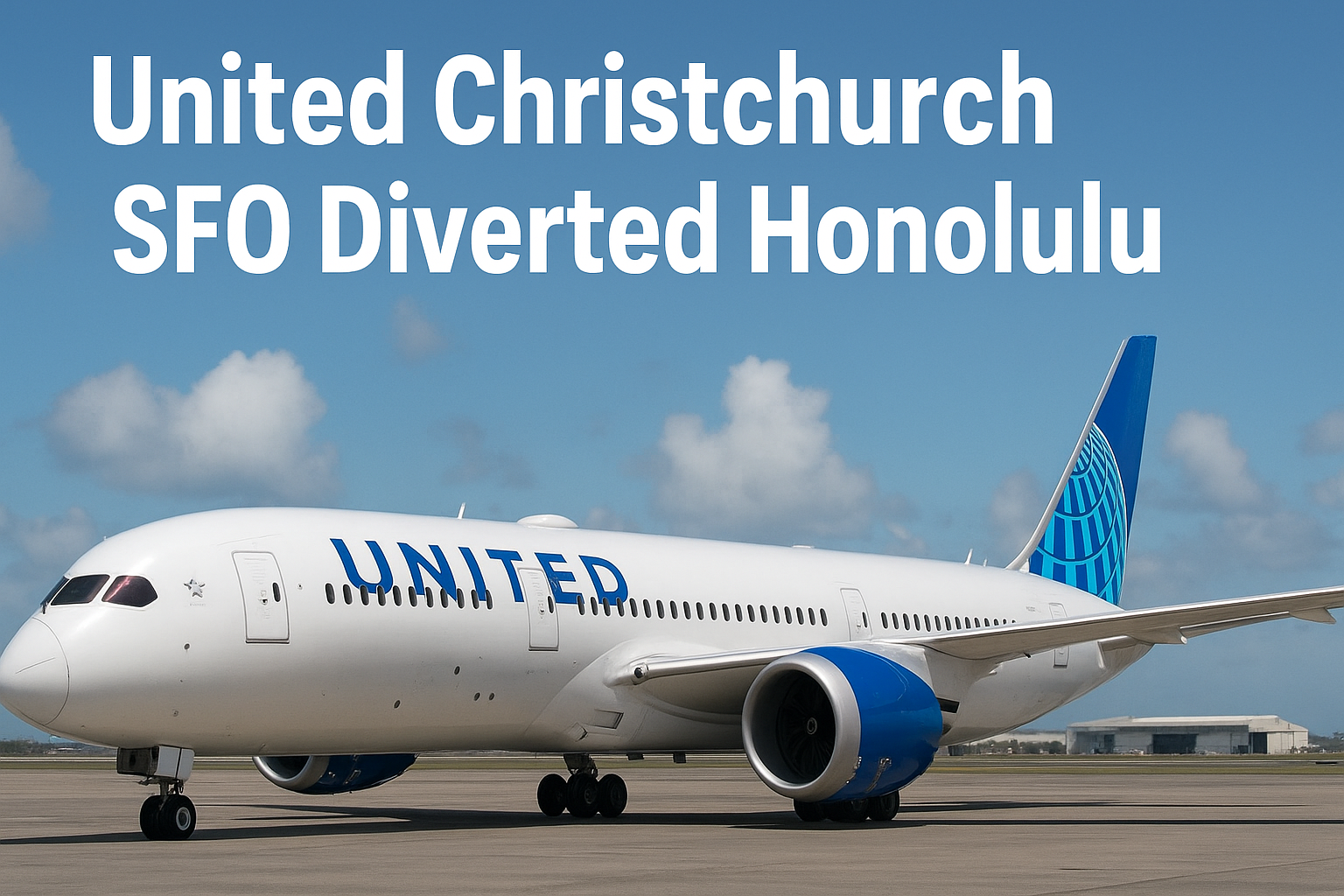Air travel is known for its efficiency, convenience, and global connectivity, but it also comes with the possibility of sudden disruptions. Recently, passengers on a United Airlines flight from Christchurch (CHC) to San Francisco (SFO) experienced one such event when the service was diverted to Honolulu (HNL) instead of continuing to its intended destination. This incident quickly drew attention from aviation enthusiasts, frequent flyers, and the travel community.
The phrase “united christchurch sfo diverted honolulu” began circulating online as people sought clarity about what had happened, why the flight was diverted, and how passengers were affected. In this article, we will explore the details of the diversion, possible reasons behind it, its impact on passengers, and what it means for United Airlines’ operations on long-haul Pacific routes.
United Airlines’ Christchurch to San Francisco Route
United Airlines’ connection between Christchurch, New Zealand, and San Francisco, USA, is one of the most significant trans-Pacific services. It not only connects two major international hubs but also supports tourism, business travel, and family visits between the Southern Hemisphere and North America.
The Christchurch–San Francisco service is usually operated by a modern long-haul aircraft, providing direct access for New Zealand travelers to California and beyond. It has grown in popularity due to its convenience, eliminating the need for stopovers in other cities. Because of this, any disruption—like the united christchurch sfo diverted honolulu incident—can affect hundreds of passengers and even broader travel plans.
Why Flights Sometimes Get Diverted
Although aviation is one of the safest industries in the world, diversions are sometimes necessary. A diversion happens when a flight cannot land at its intended destination and must be redirected to an alternate airport. Reasons for such diversions include:
-
Weather Conditions: Poor visibility, strong crosswinds, or storms at the destination airport can make it unsafe to land.
-
Technical Concerns: Aircraft systems might require attention, and airlines prefer to land safely at an alternate airport rather than risk continuing the journey.
-
Medical Emergencies: Passenger or crew health issues can force a diversion to the nearest suitable airport.
-
Airspace Restrictions: Changes in flight clearance or unexpected restrictions en route may require a new landing location.
-
Fuel and Operational Limits: Sometimes, unexpected headwinds or delays may alter the fuel calculations, requiring a technical stop.
For the united christchurch sfo diverted honolulu case, the diversion to Honolulu was a logical choice, as the Hawaiian city is strategically located in the Pacific and has facilities to handle large international flights.
The Honolulu Diversion Explained
When the Christchurch to San Francisco flight was unable to continue its planned path, the crew made the decision to divert to Daniel K. Inouye International Airport (HNL) in Honolulu. This is a common diversion airport for flights crossing the Pacific Ocean because:
-
It is equipped with long runways suitable for wide-body aircraft.
-
It has customs and immigration facilities for international passengers.
-
It offers maintenance support for technical issues.
-
It serves as a halfway point between New Zealand and the mainland United States.
The united christchurch sfo diverted honolulu event was managed smoothly, with the aircraft landing safely and passengers provided with assistance while the airline worked on onward connections.
Passenger Experience During the Diversion
For passengers, diversions can be both stressful and confusing. Travelers on this flight experienced delays in reaching their final destination, with some having to stay overnight in Honolulu before being rebooked onto connecting flights to San Francisco or other U.S. cities.
United Airlines typically offers support during such events, including:
-
Hotel accommodations if necessary.
-
Meal vouchers.
-
Ground transportation between the airport and hotels.
-
Updated flight itineraries and assistance at customer service desks.
Although delays are inconvenient, the overwhelming priority in aviation is always safety. Passengers affected by the united christchurch sfo diverted honolulu diversion may have lost some time, but they ultimately reached their destinations with safety ensured.
Aviation Safety and Diversions
One of the key takeaways from this event is the importance of diversions in maintaining aviation safety. Airlines are heavily regulated and are required to prioritize precautionary actions over schedule adherence. A diversion is not a failure—it is a demonstration of how well the aviation system works to protect lives.
Aircraft crews are trained to handle these situations calmly and efficiently. In fact, diversions like the united christchurch sfo diverted honolulu case show passengers that United Airlines and the aviation industry as a whole place a higher value on safety than punctuality.
Impact on Airline Operations
For United Airlines, diversions can have operational and financial implications. A long-haul aircraft being grounded in an unscheduled city can lead to:
-
Crew duty time limitations requiring additional staffing.
-
Extra costs for fuel, landing fees, and ground services.
-
Rebooking complexities for passengers with tight connections.
-
Scheduling challenges for the next planned flights.
Despite these challenges, airlines like United have contingency systems in place to minimize disruption. The ability to handle unexpected events like united christchurch sfo diverted honolulu also reflects United’s resilience as a global carrier.
Honolulu as a Diversion Hub
It is worth noting why Honolulu is such a frequent choice for diversions. The airport is located almost midway between Australasia and the U.S. West Coast, making it geographically ideal. In addition, Hawaii is a U.S. state, meaning passengers can clear immigration there before continuing to other American destinations.
Over the decades, Honolulu has become a trusted diversion point for many trans-Pacific flights, not just United’s Christchurch–San Francisco service. The united christchurch sfo diverted honolulu incident fits into this long-standing pattern.
Traveler Lessons From the Diversion
Events like these can serve as learning experiences for frequent travelers. Here are some tips passengers can keep in mind:
-
Always allow buffer time for international connections.
-
Travel insurance can help cover hotel stays or unexpected expenses during diversions.
-
Stay informed by checking flight status updates through airline apps.
-
Be flexible and patient, as diversions are always made with safety in mind.
Passengers affected by the united christchurch sfo diverted honolulu diversion were reminded of the importance of flexibility in long-haul travel.
Read also: The Rising Impact of Tubehalote in Modern Technology and Innovation
Conclusion: Safety Above All
The united christchurch sfo diverted honolulu incident may have caused temporary disruption, but it also reinforced the highest principle of air travel: passenger safety. While travelers experienced delays and rerouting, the safe handling of the diversion highlighted the professionalism of the flight crew and the robustness of aviation procedures.
United Airlines continues to operate the Christchurch–San Francisco route, and diversions remain rare compared to the thousands of successful flights completed each day. For passengers, the takeaway is clear: while schedules are important, nothing is more valuable than the assurance of arriving safely.


